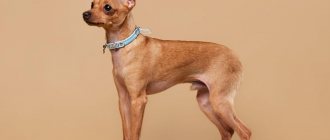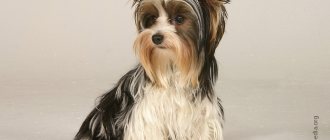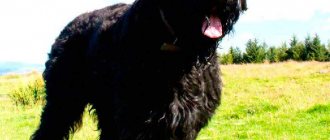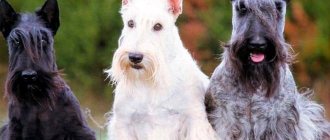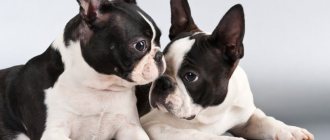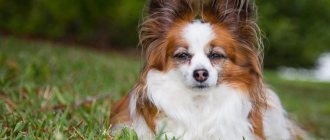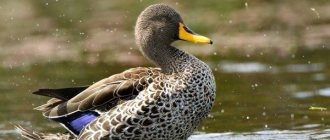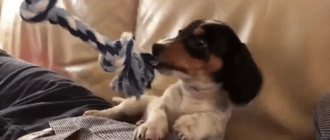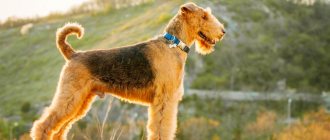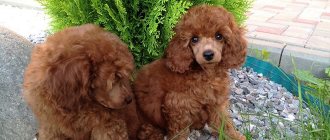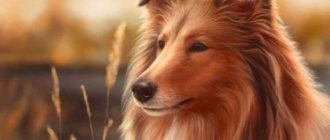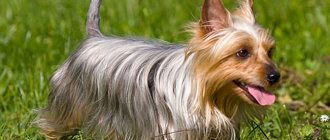The Toy Terrier is a cheerful and mischievous dog that can easily brighten up even the drabest everyday life.
They always remain devoted to their owner, without hesitation they will come to his defense, and their small stature is not a hindrance for them.
These dogs belong to the category of companions.
They easily perform their main function - to be a good and responsive friend.
Toy terriers have a completely accommodating character: you can always find an approach to them.
They only do not tolerate rudeness towards them and may become offended and even stop eating.
Breed characteristics
| Short description | |
| Origin: | Russia |
| Conditions of detention: | House, apartment |
| Purpose: | Decorative dog, companion dog |
| Color: | Rich red, black, black and tan, brown and tan, fawn, lilac |
| Wool length: | Smooth-haired cats have short, close-fitting hair; for long-haired dogs - medium (3-5 cm) with feathering on the ears |
| Adult dog size: | Height 20-28 cm, weight – up to 3 kg |
| Average life expectancy: | 12-15 years |
| Walk: | Walking twice a day is recommended |
| Physical activity needs: | Low physical activity needs (40-60 minutes of walking per day) |
| Fédération Cynologique Internationale (FIC) classification: | Group 9: Toy dogs and companions, Section 9: Continental Toy Spaniel and Russian Toy Terrier |
| Puppy price: | From 20,000 to 60,000 rubles. Without pedigree - up to 20,000 rubles, pet class - 20,000-25,000 rubles, breed class - 30,000-40,000 rubles, show class - 60,000 rubles |
Varieties of colors
Representatives of the Russian terrier breed can come in all sorts of colors. The variety of shades is due to the intricate genetics of the breed. To determine what color the offspring will have, you need to follow the history of the origin of the toy.
Standard Toy Terrier colors with tan:
- black;
- brown;
- lilac;
- blue;
The same colors listed above and two more tones can alternate with red, such as:
- pale yellow;
- cream.
Saturated shades are considered more preferable, as in the photo. Non-standard toy terrier colors include marbled, spotted, gray, and white.
But owners often care about the character of the pet, not its color.
History of the origin of the species
The breed originated from English toy terriers, who already in the 17th and 18th centuries were engaged in important work - clearing city streets of rats. Later, the dogs migrated to the boudoirs of noble ladies and, in fact, remain there to this day.
Animals came to Russia long before the revolution. Peter 1 especially loved them. The dogs of that time were larger, more massive, and could hunt small animals and even foxes. But after the change of power, dogs were not only considered undesirable, but also destroyed as a symbol of bourgeois life. Thus, in the 20-50s of the 20th century, decorative dogs were practically not bred in Russia, and imports from abroad were not widespread.
Cynologists and amateurs restored and “glued together” the English Toy Terrier from those individuals that were in the USSR. The animals acquired a new appearance and were no longer at all similar to their ancestors. In 1958, the first long-haired Toy appeared, but it was immediately discarded.
The puppy fell into the hands of breeder E.F. Zharova, and she is considered the “mother” of the breed. In the Moscow nursery, new Toy Terriers were bred - Russian Longhaired. Shorthairs were also not ignored. They also acquired their own individual appearance. The first exhibition was held in 1996. Dogs are recognized in Russia. The breed received international recognition only in 2022.
Distinctive features
A graceful, square-shaped dog with long limbs, a thin skeleton and medium-developed muscles. The animals' height is 20-28 cm, and their weight is up to 3 kg.
Two varieties: smooth-haired and long-haired toy are equally valued and included in one standard. Longhairs are characterized by symmetrical feathering on the ears and limbs, as well as a collar on the neck. In all other respects the dogs are identical.
- The head is small, round, shallow, square in shape.
- The muzzle is shorter than the skull, pointed, with flat cheekbones . The jaw is small, with a scissor bite. Lips are thin.
- The nose is small, the color depends on the coat;
- The eyes are set wide, large, protruding, shiny. The iris is dark.
- The ears are set high, stand on cartilage, are large in size, but thin.
- The body is fragile and elegant. The back is inclined towards the tail, the withers are pronounced, the loin is convex, the croup is sloping. The stomach is tucked.
- The tail is sickle-shaped, held towards the top; usually stopped by 2/3.
- The limbs are dry, thin, long (about 65% of height), straight and parallel. Paws are oval. The movements are fast.
- The coat is either short and close-lying, or medium (5-6 cm), straight or wavy, forming long feathering on the ears, tail, limbs, and neck.
- Colors: red, black and tan, brown and tan, blue and tan, lilac.
Photo of an adult dog
Photos of puppies
Advantages
The advantages of the breed include:
- Kindness, lack of aggression, cuteness;
- Good mental abilities and learning ability;
- They behave wonderfully when traveling and can easily tolerate changes in environment;
- Devotion to the family, boundless love for the owner, affection;
- Good security qualities, despite its size;
- Compact, convenient, undemanding in content.
Flaws
There are no bad dogs, only ill-mannered ones. The character of a pet depends on several factors: heredity, manners instilled by the owner, psychological trauma. The chance of getting a healthy, balanced pet is much higher if the purchase is made at a nursery.
Most individuals have the following disadvantages:
- Mental instability, attacks of aggression and anger;
- Dislike for children, strangers, animals;
- Selfishness, jealous attitude towards personal objects and owners;
- Destructiveness (gnaw, scratch, drag everything they see)
- Fragility, pain, difficult childbirth.
Care and maintenance
These dogs are absolutely not allowed to live on the street. Not only because of its size, but also because of its instability to sudden weather changes. Apartment housing is suitable for them, even without walking (with a home toilet).
There are no special rules for the care and maintenance of these dogs. Like all decorative breeds, they do not require large amounts of feed. They don’t even always need a lounger, because they usually sleep next to their owner.
Before buying a dog, you will still have to purchase some items for daily use: bowls on stands, a leash and collar (or harness), litter tray, toys, hygiene products.
Nutrition
The good thing about keeping a small dog is that it doesn't require a lot of food. An adult Toy will need up to 300 grams of food diluted with water or broth per day. Therefore, many dog breeders choose dry foods. They are easy to use and do not require refrigeration, cooking or wasting extra time. These dogs will benefit from holistic (grain-free) super-premium food for small breeds.
You need to carefully choose the product to eliminate possible digestive problems. Low-quality food contains elements that can harm your pet. Therefore, it is important to read the composition, find out the opinions of breeders and dog breeders on forums.
Adult pets are fed twice a day: morning and evening. A puppy needs 4-5 meals a day until 3 months, 3 meals a day until 6-7 months, then you can switch to adult feeding.
Large pieces for chewing can be given from 3-4 months. In summer, the serving size is reduced, and in winter it is increased.
Natural food is familiar to dogs; it is considered correct and healthy, although it does not contain all the necessary microelements, like dry food. Therefore, animals are additionally fed with vitamins.
The diet should consist of 50% proteins:
- Lean meat;
- Eggs;
- Boiled sea fish without bones;
- Kefir;
- Cottage cheese.
Another 30-40% is given to cereals: cereals boiled in broth or water. The rest of the space is occupied by vegetables and fruits.
The following products are strictly not permitted:
- Bones;
- Pork;
- Butter;
- Legumes and potatoes;
- Citrus;
- Floury and sweet;
- Fried, smoked and fatty.
It is also prohibited to feed the dog from the table, and all attempts at begging are suppressed . You can pick up treats at a pet store or use low-fat varieties of cheese. It is not recommended to mix dry and natural food.
You must follow a drinking regime. The bowl of water should always be full, especially in the summer when food portions are reduced. If the puppy does not drink, he should be given water from a syringe or pipette, gradually teaching him to drink on his own.
We recommend that you read a detailed article on the topic: “How and what to feed a dog: types and characteristics of nutrition.”
Health
These dogs are quite sickly, but live a long life of 15-20 years with proper care. Problems occur due to poor heredity and illiterate care.
In addition, they are fragile and can be injured from a minor bruise or falling from a low sofa.
It is important to vaccinate the animal on time, take it to a veterinary clinic for examination, and monitor its condition, color of discharge, and appetite.
Vaccinations
Even small indoor pets that do not walk outside and do not have contact with other animals need vaccination. A person carries a huge amount of bacteria and viruses on himself, his clothes and household items, so a dog can become infected without even leaving the house.
Vaccination does not provide 100% protection against infection, but it prevents dangerous diseases and helps to cure them faster. Unvaccinated animals are not able to overcome the virus and, most often, die in the early stages.
The vaccination calendar is especially busy in the first year of a puppy’s life. Because during this period the animal is especially vulnerable without the mother’s immunity. Primary vaccination is usually carried out in the nursery.
But the owner must be informed about the timing of further procedures:
- Complex vaccination is carried out at 2, 2.5, 6, 12 months and requires annual renewal;
- Rabies vaccination is carried out at 7 months and also requires annual renewal.
In addition to the protective function of vaccination, they also have a registration function. All procedures are recorded in the dog’s veterinary passport. Without basic vaccinations, an animal cannot be transported across the border. A prerequisite is that vaccination must be done in the last 12 months, but no later than 20 days before transportation. Also, the pet must be taken to the veterinarian in advance for examination.
Important article on the topic: “Everything you need to know about dog vaccinations.”
Diseases
Toy terriers are small and fragile, and they often have health problems. Diseases can be transmitted from parents, or can develop due to improper care or stress. Problems specific to the breed:
- Dislocations, fractures, sprains, concussions, necrosis of the femoral head;
- Allergies, digestive problems, bloating, pancreatitis;
- Cataracts, retinal atrophy, conjunctivitis;
- Decreased blood sugar, epilepsy, seizures.
Walk
Walking is not mandatory for these pets. They don't have to burn off energy during hard workouts, and they can go to the toilet in their indoor litter box. But, as with all dogs, interaction with the environment is the best way to spend time. Toys can be walked 2 times a day for 30-40 minutes.
Puppies begin to be walked at 3 months, after the second vaccination. First, they are carried out in their arms, after 3-4 days they are lowered to the ground and accustomed to a leash. For the first two weeks, it is better to choose quiet places for a walk; as you socialize, you can experiment with noisy highways and avenues.
Toy terriers are not friendly. They do not particularly like other animals, strangers, or children. But with proper upbringing, these dogs have normal contact with others.
These dogs do not have an undercoat, so they freeze in cold weather and overheat in warm weather. In frosty, dirty or cool weather, animals wear insulated protective overalls. In summer you need to avoid sun rays.
Grooming
These dogs practically do not shed. Short-haired cats do not require regular brushing at all, although dead hairs need to be removed periodically. Long-haired pets are brushed 3-5 times a week with a long-toothed brush. They are bathed every 2-3 weeks, and their smooth-haired counterparts once a month.
It is important to monitor the condition of your teeth. Due to their picky eating habits, Toys do not brush their teeth with large pieces or hard foods, and they also do not like special chewy treats.
Therefore, brushing your teeth is an important monthly procedure that prevents the appearance of tartar and other problems with the oral cavity.
The eyes and ears are examined regularly to check for inflammation. Claws are trimmed with special pliers once a month. After walks, be sure to wash your paws under warm water. If the pads become rough or crack, they are lubricated with baby cream.
In the summer, be sure to treat your pet for fleas and ticks. This can be done using special solutions, powders or shampoos; collars are also sold. We must not forget about deworming - cleansing of worms. It is carried out once every 2 months.
Nutrition
If you plan to feed your Toy Terrier dry food, then choose a balanced dog food. The first rule regarding toy terriers is a ban on food from the human table. The pet needs a separate menu, which, among other things, is compiled correctly, taking into account all the important vitamins and minerals.
The basis of the diet is marine fish, lean meats, fermented milk products such as fermented baked milk, cottage cheese and kefir, chicken and quail yolks, as well as vegetables and fruits, honey and even seaweed.
Toy terrier puppies
Don’t forget about cereals, but you shouldn’t pamper your toy terrier with sausages, smoked meats, canned food and fried treats. You should also not give homemade fatty pork. Bones are also prohibited! As a percentage, meat and fish occupy the main share of the diet. A small percentage consists of cereals, fruits and vegetables. They help the stomach function smoothly.
As for the frequency of meals, despite the excellent appetite and the desire to grab a piece in addition to breakfast-lunch-dinner, you should show character and feed the dog according to the schedule.
Otherwise, there is a risk that the dog will become obese and get sick often. Toy terrier puppies eat up to six times a day, and adults eat twice a day; it is better if they are fed after walks.
Toy terriers play around with each other
Also, babies under three months should be given vitamins and anti-worm medications from time to time. If the puppy's weight allows, it is worth getting vaccinated.
Mating
Toys are easier to breed than large dogs. They don’t need a long introduction, a long walk, or a lot of free space. But to untie the dogs, it is still recommended to invite a trained person who will tell you how to properly help the animals.
Puberty comes to these dogs early: at 8-10 months, the bitch begins her first heat, and males mount soft toys or furniture. This habit needs to be weaned off gently, but you should not scold your pet so as not to disturb its psyche. Otherwise, adult Toy simply will not want to mount a girl.
Toy terriers can be untied at 20-25 months, when their bodies are able to conceive and bear offspring. At this time, the girl should go into her third heat. The most favorable time is 13-15 days from the beginning, when light discharge appears, the loop loosens, and the bitch’s behavior changes to playful.
If the dogs are breeding dogs and have status, then they need to be bred through a kennel. Owners must fill out certain forms and obtain a certificate. The male is selected in advance, the owners set a date and determine the price. It is usually equal to one puppy or a percentage of its value, depending on the number of heads in the litter. If the bitch is empty, mating is not paid.
The girl is brought into the territory of the male dog, where he will feel relaxed. When the boy makes the cage, the animals need to be helped: hold them so that they do not lose their balance, guide the male into the loop. Sexual intercourse lasts 10-15 minutes . Even in the absence of a castle, the female can be plump. Mating is repeated after 2 days .
Read a detailed article on the topic: “Everything you need to know about breeding dogs: appropriate age, what to do if it doesn’t work out, rules and tips.”
Nicknames of toy terriers
A cute and funny pet usually gets a corresponding cute nickname. You can name a boy a toy terrier taking into account one of the following factors:
- small size dogs: Funtik, Malysh, Krosh;
- cheerful character of the pet: Shumok, Volcano, Energizer.
Nicknames for girls are selected according to the same principle, but in such a way that they emphasize the elegance and grace of a small dog: Barbie, Bead, Doll, Lady, Princess, Jasmine.
Sometimes the owners approach this issue with humor, then tiny Tyson, Thunder, Giant or Yula, Tyapa, Knopochka rush around the apartment.
Key points in training
Since this breed is decorative, their representatives are usually not trained. They have enough knowledge of basic commands, but the skill of executing them must be honed to perfection. Russian Toys are rarely obedient and flexible, but with proper upbringing they can be taught basic techniques:
- "Sit";
- "Voice";
- "Near";
- "Place".
Raising puppies begins from the first months of life. To prevent the dog from becoming the head of the family, you must not allow him to manipulate people.
You cannot feed from the master's table, teach him to sleep and jump on the master's furniture, or enter the house before other family members.
The owner needs to be persistent, strict, but not rude. They are vindictive and fragile; a slight blow can disrupt their nervous system.
Read about how to properly train a dog in the article: “Training a puppy: effective methods from dog handlers, learning commands at home.”
Briefly about character
Dogs are easy to train , but sometimes they may not obey, so in raising and training you need to show as much perseverance as possible and not let the dog get the better of you .
This breed does not tolerate loneliness; when left alone, it begins to whine and bark, and may even get sick.
They are very playful and active and love walks. They will be happy to share with you all the pleasure of playing together.
There are dogs with different temperaments and characters . If you don't like your dog's behavior, a serious approach to training can change everything.
How to choose a puppy
Russian Terrier puppies should be long-legged, square in size, with large eyes, clean fur without white spots. You can pick up a puppy from its mother at 2-3 months; usually, dog breeders prefer this age. But small dogs are much more demanding in care; they need to be given more attention: fed more often, walked more often. At 5-6 months, dogs are more independent and have a mature appearance, by which class can be determined. Such pets will be more expensive, they are more difficult to train, but do not require excessive care.
Before purchasing, you need to decide on the gender and desired class of your future pet. Bitches, as a rule, are softer, more affectionate, and males are more temperamental . The class of an animal determines its value and future career. There are three classes: pet, breed and show.
- The first is considered the cheapest; puppies may have minor defects that will not prevent them from being pets.
- Dogs of the second class have ideal external characteristics, which allows them to become breeding dogs (suitable for breeding).
- Show class defines a pet as a show one, with good pedigree and data.
Toy terriers are distributed all over the world, so purchasing a puppy will not be a problem. The purchase can be made at an official nursery or from a private person. A good breeder will definitely provide a package of necessary documents, tell you about the breed line and the conditions for keeping the puppies.
Healthy dogs are active and inquisitive, without obvious shortcomings or deviations from the standard. The cost of such a puppy varies from 20 to 60 thousand rubles. It depends on the class of the animal and the status of the nursery.
Upbringing
Despite their diminutive size, they are still terriers, and they have a rather serious character with a bright temperament. Toys are perfectly trainable and if aggression is noticed in a puppy, it should be sent for re-education. This will help avoid problems with aggression in the future. However, “characteristic” toys are a rarity; most of them are cute and cheerful dogs.
It is important to remember that a “lap” dog is not a cat that walks on its own, nor is it a toy. She has her own needs, characteristics and instincts. If this is neglected, then the risk of developing “small dog syndrome” or “Napoleon complex” increases in the toy terrier. At the same time, the dog will become uncontrollable: he will consider himself the main one in the house, bark at everything that does not suit him, and rush at others.
To avoid excessive self-will, you must strictly follow a number of rules:
- do not allow him to aggressively jump on people;
- do not allow barking and growling whenever you want;
- make sure that the dog does not climb onto your lap on its own;
- prohibit sleeping on the owner's pillow.
